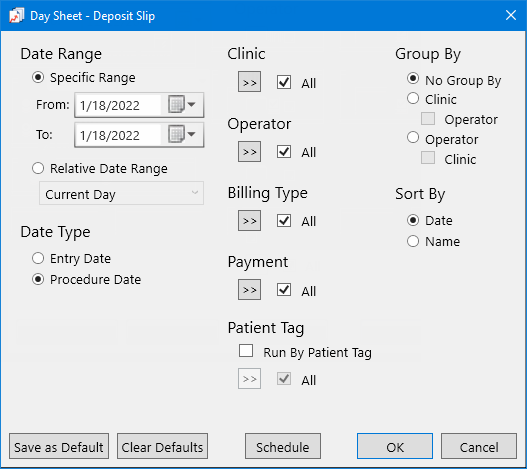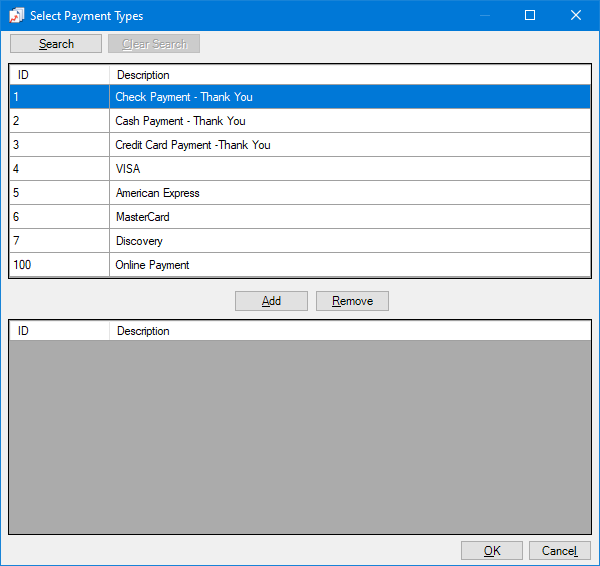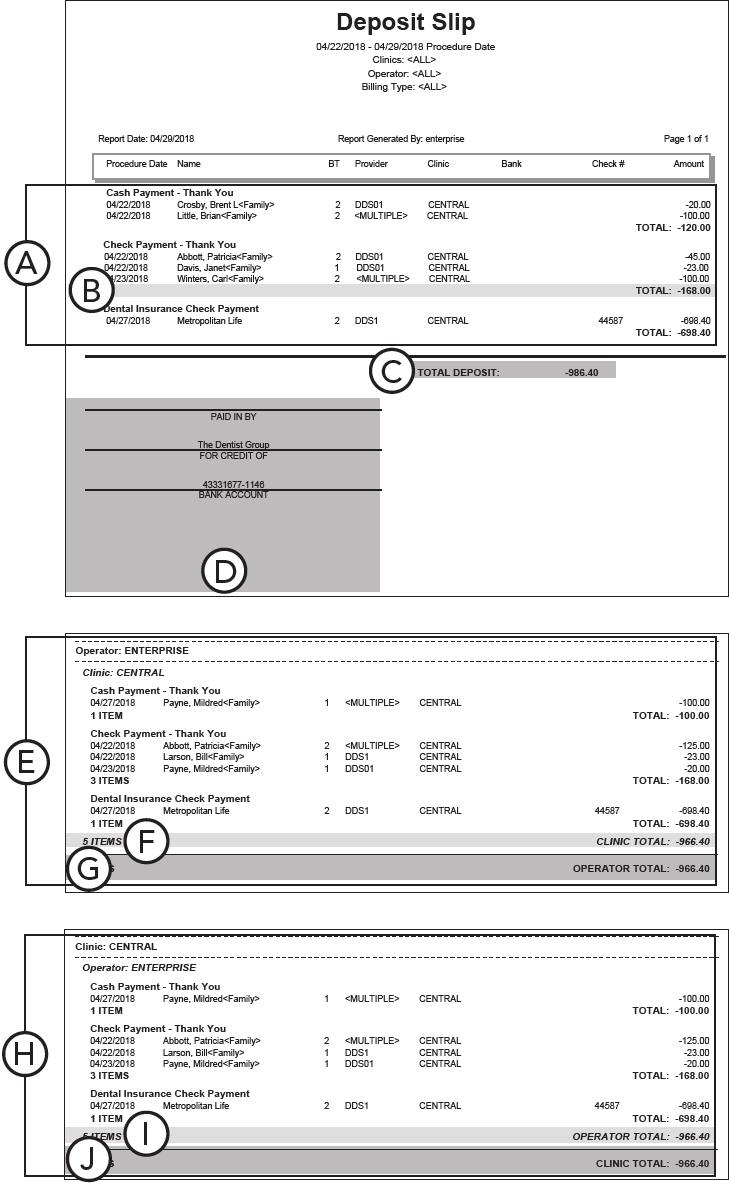The deposit slip allows you to view payments by payment type, and you can use the deposit slip to deposit cash and checks at your bank.
|
Why: |
To save time by automatically generating deposit slips and to ensure cash, check, and credit card totals match up at the end of each day (in other words, the amount of cash left in the till is correct, each check has been accounted for, and the total charges processed on your credit card machine are correct) |
When: |
Daily |
To generate the report
In DXOne Reporting, select Management, and then double-click Day Sheet - Deposit Slip.
The Day Sheet - Deposit Slip dialog box appears.

Set up the following options:
Date Range - To filter the report by date, do one of the following:
To include payments that have dates (based on the Date Type) within a range that you specify, select the Specific Range option. With this option selected, do one of the following:
Enter a date range (in a m/d/yyyy format) in the From and To boxes.
To select a date, do the following for From and To:
Click the corresponding calendar icon to view a month calendar.

Navigate to the correct month, using the left and right arrows.
Note: To quickly change the year and month, click the month-year at the top of the calendar, navigate to the correct year, using the left and right arrows, and then click the correct month.
Click the correct day.
To include payments that have dates (based on the Date Type) within a range that is relative to the report date, select the Relative Date Range option. With this option selected, select one of the following relative date ranges from the list:
Current Day Current MTD Current Fiscal YTD Current Calendar YTD |
Previous Day Previous Week Previous Month Previous 3 Months Previous 6 Months Previous Fiscal Year Previous Calendar Year |
Next Day Next Week Next Month Next 3 Months Next 6 Months Next Fiscal Year Next Calendar Year |
Date Type - Select one of the following options:
Entry Date - To include a payment based on the date that it was created (entered into the database).
Procedure Date - To include a payment based on the date that was specified for it.
Notes: Most of the time, a payment will have the same entry and procedure date. They will differ only if you backdate the payment.
Clinic - To filter the report by the clinics that are associated with payments, do one of the following:
To include all clinics that you are allowed to generate the report for, select the All checkbox.
To include specific clinics, do the following:
Click the search button  .
.
The Select Clinics dialog box appears.

Note: Only the clinics that you are allowed to generate the report for are available.
If the list is long, to search for a clinic by ID and/or title, do the following:
Click Search.
The options for searching appear in the upper list.

Enter the first character or more of a clinic's ID and/or title in the ID and Practice Title boxes, respectively.
Click Show Results to view a list of matching clinics.
Note: To return to viewing the list of all the clinics, click Search, click Clear Search to clear the search criteria that you entered, and then click Show Results.
In the upper list, select one or more clinics.
Note: To select multiple clinics, click a clinic, and then, while pressing the Ctrl key, click the other desired clinics. To select a range of adjacent clinics, click the first clinic of the desired range of clinics, and then, while pressing the Shift key, click the last clinic of the desired range of clinics.
Click Add.
Repeat steps b-d as needed to add other clinics.
Note: To not include a clinic that you added, select that clinic in the lower list, and then click Remove.
Click OK.
Operator - To filter the report by the users who entered payments while logged in to Dentrix Enterprise, do one of the following:
To include all users, select the All check box.
To include specific users, do the following:
Click the search button  .
.
The Select Providers/Staff dialog box appears.

Note: Only the providers and staff that you are allowed to generate the report for are available.
If the list is long, to search for a user by ID, first name, last name, and/or title, do the following:
Click Search.
The options for searching appear in the upper list.

Enter the first character or more of a user's ID, first name, last name, and/or title in the ID, First Name, Last Name, and Title boxes, respectively.
Click Show Results to view a list of matching users.
Note: To return to viewing the list of all the providers and staff members, click Search, click Clear Search to clear the search criteria that you entered, and then click Show Results.
In the upper list, select one or more users.
Note: To select multiple users, click a user, and then, while pressing the Ctrl key, click the other desired users. To select a range of adjacent users, click the first user of the desired range of users, and then, while pressing the Shift key, click the last user of the desired range of users.
Click Add.
Repeat steps b-d as needed to add other users.
Note: To not include a user that you added, select that user in the lower list, and then click Remove.
Click OK.
Billing Type - To filter the report by the billing types that are associated with patients who have payments entered in their records, do one of the following:
To include all billing types, select the All checkbox.
To include specific billing types, do the following:
Click the search button  .
.
The Select Billing Type dialog box appears.

If the list is long, to search for a billing type by ID and/or description, do the following:
Click Search.
The options for searching appear in the upper list.

Enter the first character or more of a billing type's ID and/or description in the ID and Description boxes, respectively.
Click Show Results to view a list of matching billing types.
Note: To return to viewing the list of all the billing types, click Search, click Clear Search to clear the search criteria that you entered, and then click Show Results.
In the upper list, select one or more billing types.
Note: To select multiple billing types, click a billing type, and then, while pressing the Ctrl key, click the other desired billing types. To select a range of adjacent billing types, click the first billing type of the desired range of billing types, and then, while pressing the Shift key, click the last billing type of the desired range of billing types.
Click Add.
Repeat steps b-d as needed to add other billing types.
Note: To not include a billing type that you added, select that billing type in the lower list, and then click Remove.
Click OK.
Payment - To filter the report by payment type, do one of the following:
To include all payment types, select the All checkbox.
To include specific payment types, do the following:
Click the search button  .
.
The Select Payment Types dialog box appears.

If the list is long, to search for a payment type by ID and/or description, do the following:
Click Search.
The options for searching appear in the upper list.

Enter the first character or more of a payment type's ID and/or description in the ID and Description boxes, respectively.
Click Show Results to view a list of matching payment types.
Note: To return to viewing the list of all the payment types, click Search, click Clear Search to clear the search criteria that you entered, and then click Show Results.
In the upper list, select one or more payment types.
Note: To select multiple payment types, click a payment type, and then, while pressing the Ctrl key, click the other desired payment types. To select a range of adjacent payment types, click the first payment type of the desired range of payment types, and then, while pressing the Shift key, click the last payment type of the desired range of payment types.
Click Add.
Repeat steps b-d as needed to add other payment types.
Note: To not include a payment type that you added, select that payment type in the lower list, and then click Remove.
Click OK.
Patient Tag - Do one of the following:
To not filter the report by a patient tag, clear the Run By Patient Tag checkbox.
To filter the report by the tags that are assigned to patients, select the Run By Patient Tag checkbox. With this checkbox selected, the options to filter the report by tag are available. Do one of the following:
To include payments for patients with any patient tag, select the All checkbox.
To include payments for patients with specific tags, do the following:
Click the search button ![]() .
.
The Patient Tag Selection dialog box appears.

If the list is long, to search for a patient tag, do the following:
Click Search.
The options for searching appear in the upper list.

Enter the first character or more of a patient tag name in the Tag Name box.
Click Show Results to view a list of matching patient tags.
Note: To return to viewing the list of all the patient tags, click Search, click Clear Search to clear the search criteria that you entered, and then click Show Results.
In the upper list, select one or more patient tags.
Note: To select multiple patient tags, click a patient tag, and then, while pressing the Ctrl key, click the other desired patient tags. To select a range of adjacent patient tags, click the first patient tag of the desired range of patient tags, and then, while pressing the Shift key, click the last patient tag of the desired range of patient tags.
Click Add.
Repeat steps b-d as needed to add other patient tags.
Note: To not include a patient tag that you added, select that patient tag in the lower list, and then click Remove.
Click OK.
Group By - Select one of the following options:
No Group By - For no grouping. Only the grand totals appear on the report. The totals are not broken down by collecting clinic or operator.
Clinic - To group the report by collecting clinic. The totals are broken down by clinic, and the report displays grand totals.
Do one of the following:
To not group the report by operator within each clinic grouping, clear the Operator checkbox.
To group the report by operator within each clinic grouping, select the Operator checkbox. For each operator, the report displays totals that are related to the outer clinic grouping.
Operator - To group the report by operator. The totals are broken down by operator, and the report displays grand totals.
Do one of the following:
To not group the report by collecting clinic within each provider grouping, clear the Clinic checkbox.
To group the report by collecting clinic within each provider grouping, select the Clinic checkbox. For each clinic, the report displays totals that are related to the outer provider grouping.
Sort By - Select one of the following options:
Date - To sort the payments chronologically (based on the Date Type).
Name - To sort the payments alphabetically by the last names of patients.
Click Save as Default to save the current settings for the next time you run the report.
Click Clear Defaults to revert the dialog box options to the original defaults.
Click Schedule to schedule a report job.
Click OK to preview the report.

Important information this report provides
The following information can be used to monitor payments for each operator and/or clinic.
Payments - The payments (grouped and totaled by type) posted to Ledger.
Payment Details - Each payment provides the following information:
Procedure Date - The date of a payment posted to Ledger.
Amount - The amount of the payment.
Total Deposit - The total of all payment types.
Account Information - The following report information (except for the first item) is found in the Clinic Information dialog box:
Paid in By - The name of the employee making the deposit.
For Credit Of - The name of the practice for which the deposit is being made.
Bank Account - The practice’s bank deposit number.

Operator Payments - The payments for an operator by clinic.
Clinic Subtotal - The total for an operator by clinic.
Operator Total - The total for an operator.
Clinic Payments - The payments for a clinic by operator.
Operator Subtotal - The total for a clinic by operator.
Clinic Total - The total for a clinic.